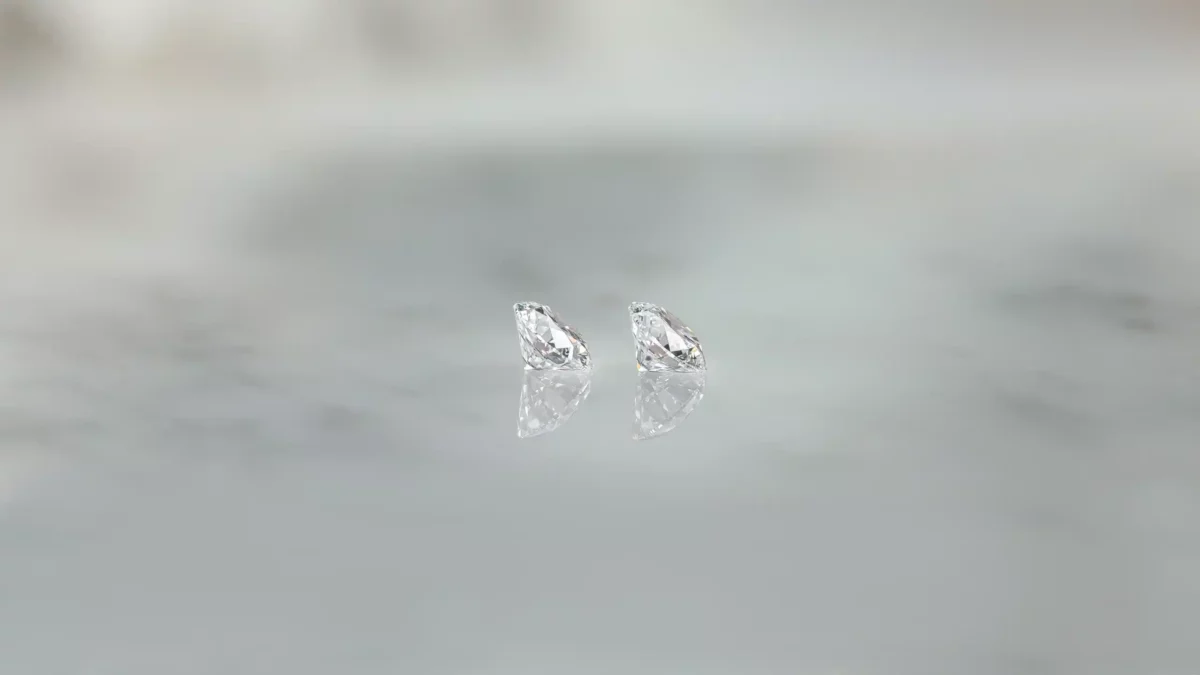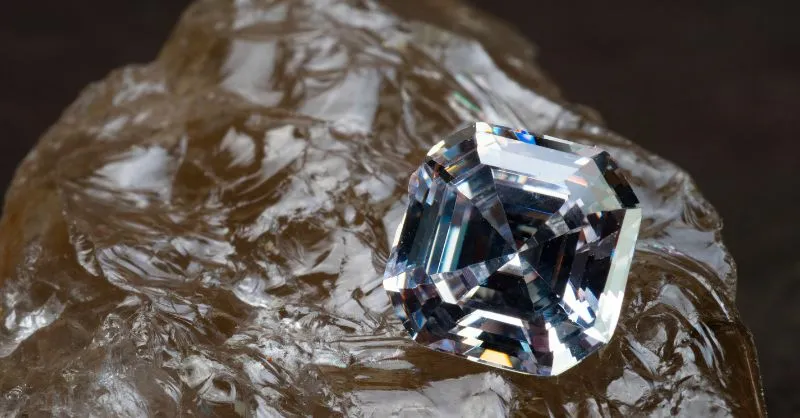

The selection of an engagement ring is a significant and meaningful decision for couples embarking on the journey of a lifetime together. Traditionally, natural diamonds have adorned these symbolic rings, but the landscape has evolved with the emergence of alternatives such as lab-grown diamonds and Moissanite.
In this article, we delve into the intricate details of Moissanite vs lab-grown vs natural diamonds, aiding you in making a well-informed decision when choosing the perfect engagement ring.
Moissanite is a naturally occurring mineral composed of silicon carbide. Its gemstone form has gained popularity as an alternative to traditional diamonds. The mineral was first discovered in 1893 by French scientist Henri Moissan in a meteor crater in Arizona.
While moissanite is found in nature, the moissanite used in jewellery is predominantly lab-created due to the scarcity of naturally occurring moissanite in quantities suitable for commercial use.
Moissanite resembles diamonds in terms of physical and optical properties. It is known for its brilliance, fire, and durability.
One of the advantages of Moissanite is its affordability compared to diamonds. Moissanite typically costs less per carat than natural diamonds, making it an attractive option for those seeking a sparkling gemstone without the hefty price tag.
While moissanite has its appeal, consumers must be aware of its differences and make an informed choice based on their preferences, budget, and the significance they attribute to the cultural and historical aspects associated with diamonds.
The status of Moissanite in the realm of fine jewellery often leads to varying opinions, with some individuals considering it a more affordable or even “cheap” alternative to natural diamonds. This perception stems from its lower cost compared to diamonds, making it accessible to a broader range of consumers. Additionally, the fact that moissanite is usually synthetic rather than a naturally occurring diamond may contribute to some’s perception that it is a less authentic or “fake” option.
While Moissanite is celebrated for its brilliance and affordability, it does have some downsides that individuals should consider when choosing an engagement ring. One notable drawback is the lower hardness of moissanite compared to diamonds. On the Mohs hardness scale, diamonds score a perfect 10, while Moissanite ranks 9.25. While still durable, this difference means that Moissanite is more susceptible to scratches over time, especially when compared to the hardness of a diamond.
Also, Moissanite may exhibit a different type of sparkle than diamonds, and under certain lighting conditions, it can display a yellow or green tint. Although these distinctions are subtle, they are noticeable to the naked eye, and some individuals prefer the colourless appearance of diamonds.

As of 2024, the price of a 1-carat lab-created Moissanite in Australia can vary based on colour, clarity, and cut. On average, you can expect a price range of approximately $600 to $1000 for a 1-carat synthetic Moissanite.
It’s important to note that prices may fluctuate due to market conditions, jeweller policies, and the specific characteristics of the Moissanite you are considering. As with any gemstone purchase, it’s advisable to consult with reputable jewellers and inquire about the particular grading and pricing criteria for the Moissanite you are interested in to ensure transparency and satisfaction with your purchase.
At Diamondport Jewellers, we prioritise providing our customers with the highest quality and most authentic selection of engagement rings. While Moissanite has gained popularity as a diamond alternative, we have chosen not to offer Moissanite engagement rings due to several considerations.
Although a beautiful gemstone with impressive sparkle, moissanite has its downsides. One notable drawback is its lower hardness compared to diamonds, which makes it more prone to scratches.
Additionally, most people prefer the cultural and historical significance associated with diamonds, and Moissanite may be perceived as a departure from the traditional symbolism that diamonds carry.
We believe in offering our customers timeless pieces with enduring value, and our commitment to quality and authenticity guides our decision not to feature Moissanite rings in our collection.

Lab diamonds, also known as lab-grown diamonds, are created through technological processes that simulate the conditions under which natural diamonds form.
These diamonds share the same physical, chemical, and optical properties as natural diamonds, offering a sustainable and ethical alternative.
See also our blog post 5 of Our Best Lab Grown Engagement Rings Crafted in Australia where we delve into the unique allure of lab-grown diamonds, discuss their advantages, peek at the differences in price, and unveil why they’ve become a sought-after choice for couples seeking both elegance and responsibility.
Lab diamonds and natural diamonds are virtually indistinguishable in appearance and composition. Both exhibit the same brilliance, hardness, and fire. However, lab diamonds offer an ethical and environmentally conscious choice, avoiding the environmental impact and ethical concerns associated with some diamond mining practices.
Spotting a fake diamond requires a keen eye and knowledge of key characteristics. One of the most effective methods is to conduct a visual inspection. Real diamonds typically have unique imperfections called inclusions, which can appear as tiny dots, lines, or clouds within the stone. While some high-quality diamonds may have few inclusions, completely flawless diamonds are exceedingly rare and often associated with diamond simulants.
Another telltale sign is the diamond’s brilliance and sparkle. Real diamonds tend to have a distinct sparkle due to their exceptional refractive index, while fake diamonds may appear duller or lacklustre in comparison. Additionally, observing the diamond’s transparency can provide valuable insight. Real quality diamonds often have exceptional clarity, allowing light to pass through effortlessly, whereas imitation diamonds may exhibit cloudy or hazy appearances.
Using a jeweller’s loupe or magnifying glass to examine the diamond’s facets can reveal further clues. Real diamonds typically have well-defined facets and sharp edges, whereas fake diamonds may have less precise cuts or irregularities in their shape and symmetry.
Additionally, it’s important to note that while a diamond simulant may appear beautiful at first, it will degrade quickly with everyday wear, losing its sparkle and accumulating scratches over time.
Individuals who unknowingly buy fake diamonds may end up paying exorbitant prices for what they believe to be genuine gemstones. This scenario not only results in financial loss but also undermines the trust and confidence of consumers in the diamond industry. Therefore, it’s crucial to exercise caution and diligence when purchasing diamonds, ensuring that authenticity is verified through reputable certification and authentication processes. By prioritising genuine diamonds from trusted sources, buyers can safeguard their investments and enjoy the enduring beauty and value associated with authentic gemstones.
Seeking certification from reputable gemological laboratories such as the Gemological Institute of Australia (GIA) or the International Gemological Institute (IGI) can provide assurance of a diamond’s authenticity. These certifications detail the diamond’s characteristics, including its cut, colour, clarity, and carat weight, offering valuable validation for prospective buyers. By combining visual inspection with certification verification, individuals can confidently identify genuine diamonds and avoid falling victim to counterfeit alternatives.

Comparing the prices of Moissanite, lab-grown, and natural diamonds unveils distinct considerations. Moissanite, often perceived as a budget-friendly alternative, is priced lower due to its synthetic nature and lower hardness. While some may find it appealing, others prioritise the enduring value associated with diamonds.
Lab-grown diamonds offer an ethical and moderately priced option, reflecting their quality and the technology involved in their creation. Natural diamonds, renowned for their rarity and timeless appeal, come with a higher price tag.
Each option caters to different preferences, with Moissanite being more affordable, lab-grown diamonds offering ethical choices, and natural diamonds representing enduring significance and value.
Yes. While Moissanite mimics the brilliance of diamonds, it exhibits a different type of sparkle. Additionally, Moissanite displays a faint yellow or green tint, albeit subtly. These distinctions contribute to the preference for natural diamonds’ timeless and colourless appearance.
When considering the choice between Moissanite and lab-created diamonds, the latter often emerges as a superior option for various reasons.
Lab-grown diamonds share identical physical, chemical, and optical properties with natural diamonds. This makes them nearly indistinguishable from their natural counterparts, providing a genuine and ethically sourced alternative.
While Moissanite may offer brilliance and affordability, lab-grown diamonds present a more authentic and sustainable choice without compromising the visual appeal or durability of traditional diamonds.
The commitment to quality, ethical practices, and the environmentally conscious nature of lab-grown diamonds often positions them as the preferred option for those seeking both value and responsibility in their engagement ring choice.
When comparing a natural diamond to Moissanite, each possesses unique characteristics that cater to different preferences.
Natural diamonds, with their deep historical and cultural significance symbolising enduring love and commitment, are renowned for their unparalleled hardness, rarity, timeless beauty and resale value. In contrast, Moissanite offers brilliance and affordability.
The choice between the two ultimately depends on individual priorities, with natural diamonds often being favoured for their authenticity, inherent symbolism, and the unique geological journey each stone undergoes, while moissanite appeals to those seeking striking budget-friendly options.
It is very challenging for the average consumer to distinguish between lab-grown and natural diamonds without specialised equipment. Gemological laboratories use advanced techniques to identify the origin of diamonds, but visual cues alone may not be sufficient for detection.
Opting for a lab diamond comes with several advantages. These diamonds are ethically sourced, eliminating concerns related to conflict diamonds. Furthermore, they are produced in controlled environments, reducing the environmental impact associated with traditional diamond mining. Lab diamonds often come with a lower price tag, making them an appealing choice for the ethically conscious buyer.
Natural diamonds carry a unique historical and cultural significance, symbolising enduring love and commitment. Some individuals place a high value on the rarity and tradition associated with natural diamonds, considering them a timeless investment that can be passed down through generations.
At DiamondPort, we ensure that our natural diamonds are also conflict-free. This reflects our commitment to ethical practices and provides customers with responsibly sourced, authentic, and enduring diamonds.
The selection of an engagement ring involves careful consideration of personal values, priorities, and budget constraints. Whether choosing Moissanite for its affordability, lab-grown diamonds for ethical sourcing, or natural diamonds for their historical significance and resale value, each option has its own set of advantages and considerations. The perfect engagement ring aligns with the unique love and commitment shared between you and your partner, reflecting your values and preferences for a lifetime.
Contemplating a proposal? Our team is here to answer all your questions – book a private complimentary consultation with us today.
Explore Rings by Cut
Explore Rings by Style
Explore Rings by Type
Services & Community
About
Contact Us
Diamondport Jewellers supports diversity in all its forms.
We acknowledge the traditional owners of the land of which we work here at Diamondport Jewellers and pay our respects to the Turrbal people and their elders both past and present.
Address: Suite 402, Level 4,
180 Queen Street, Brisbane City, 4000




Diamondport Jewellers supports diversity in all its forms.
We acknowledge the traditional owners of the land of which we work here at Diamondport Jewellers and pay our respects to the Turrbal people and their elders both past and present.